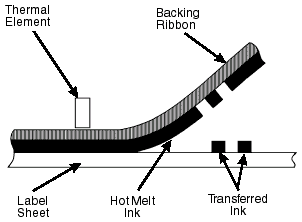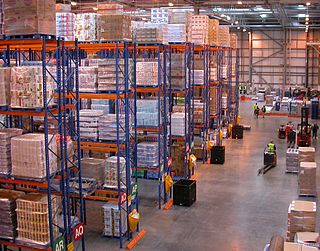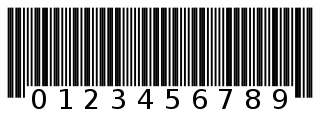
Inventory or stock refers to the goods and materials that a business holds for the ultimate goal of resale, production or utilisation.

Thermal-transfer printing is a digital printing method in which material is applied to paper by melting a coating of ribbon so that it stays glued to the material on which the print is applied. It contrasts with direct thermal printing, where no ribbon is present in the process.

Logistics automation is the application of computer software or automated machinery to improve the efficiency of logistics operations. Typically this refers to operations within a warehouse or distribution center, with broader tasks undertaken by supply chain engineering systems and enterprise resource planning systems.

A warehouse is a building for storing goods. Warehouses are used by manufacturers, importers, exporters, wholesalers, transport businesses, customs, etc. They are usually large plain buildings in industrial parks on the outskirts of cities, towns, or villages.

Packaging is the science, art and technology of enclosing or protecting products for distribution, storage, sale, and use. Packaging also refers to the process of designing, evaluating, and producing packages. Packaging can be described as a coordinated system of preparing goods for transport, warehousing, logistics, sale, and end use. Packaging contains, protects, preserves, transports, informs, and sells. In many countries it is fully integrated into government, business, institutional, industrial, and for personal use.

Thermal printing is a digital printing process which produces a printed image by passing paper with a thermochromic coating, commonly known as thermal paper, over a print head consisting of tiny electrically heated elements. The coating turns black in the areas where it is heated, producing an image.

Wristbands are encircling strips worn on the wrist or lower forearm. The term may refer to a bracelet-like band, similar to that of a wristwatch, to the cuff or other part of a sleeve that covers the wrist, or decorative or functional bands worn on the wrist for many different reasons. Wristbands are often worn and used similarly to event passes such as lanyards to information or allow people entry to events. These wristbands are made from loops of plastic that are placed around the wrist and are used for identification purposes.

A distribution center for a set of products is a warehouse or other specialized building, often with refrigeration or air conditioning, which is stocked with products (goods) to be redistributed to retailers, to wholesalers, or directly to consumers. A distribution center is a principal part, the order processing element, of the entire order fulfillment process. Distribution centers are usually thought of as being demand driven. A distribution center can also be called a warehouse, a DC, a fulfillment center, a cross-dock facility, a bulk break center, and a package handling center. The name by which the distribution center is known is commonly based on the purpose of the operation. For example, a "retail distribution center" normally distributes goods to retail stores, an "order fulfillment center" commonly distributes goods directly to consumers, and a cross-dock facility stores little or no product but distributes goods to other destinations.

A label is a piece of paper, plastic film, cloth, metal, or other material affixed to a container or product, on which is written or printed information or symbols about the product or item. Information printed directly on a container or article can also be considered labelling.

A label printer is a computer printer that prints on self-adhesive label material and/or card-stock (tags). A label printer with built-in keyboard and display for stand-alone use is often called a label maker. Label printers are different from ordinary printers because they need to have special feed mechanisms to handle rolled stock, or tear sheet (fanfold) stock. Common connectivity for label printers include RS-232 serial, Universal Serial Bus (USB), parallel, Ethernet and various kinds of wireless. Label printers have a wide variety of applications, including supply chain management, retail price marking, packaging labels, blood and laboratory specimen marking, and fixed assets management.

GS1 is a not-for-profit, international organization developing and maintaining its own standards for barcodes and the corresponding issue company prefixes. The best known of these standards is the barcode, a symbol printed on products that can be scanned electronically.

A tracking system, also known as a locating system, is used for the observing of persons or objects on the move and supplying a timely ordered sequence of location data for further processing.
In the distribution and logistics of many types of products, track and trace or tracking and tracing concerns a process of determining the current and past locations of a unique item or property. Mass serialization is the process that manufacturers go through to assign and mark each of their products with a unique identifier such as an Electronic Product Code (EPC) for track and trace purposes. The marking or "tagging" of products is usually completed within the manufacturing process through the use of various combinations of human readable or machine readable technologies such as DataMatrix barcodes or RFID.

Thermal paper is a special fine paper that is coated with a material formulated to change color locally when exposed to heat. It is used in thermal printers, particularly in inexpensive devices such as adding machines, cash registers, and credit card terminals and small, lightweight portable printers.
Smart Label, also called Smart Tag, is an extremely flat configured transponder under a conventional print-coded label, which includes chip, antenna and bonding wires as a so-called inlay. The labels, made of paper, fabric or plastics, are prepared as a paper roll with the inlays laminated between the rolled carrier and the label media for use in specially-designed printer units.

Bar code medication administration (BCMA) is a barcode system designed by Glenna Sue Kinnick to prevent medication errors in healthcare settings and to improve the quality and safety of medication administration. The overall goals of BCMA are to improve accuracy, prevent errors, and generate online records of medication administration.
Pharmacy automation involves the mechanical processes of handling and distributing medications. Any pharmacy task may be involved, including counting small objects ; measuring and mixing powders and liquids for compounding; tracking and updating customer information in databases ; and inventory management. This article focuses on the changes that have taken place in the local, or community pharmacy since the 1960s.
An automated dispensing cabinet (ADC), also called a unit-based cabinet (UBC), automated dispensing device (ADD), or automated dispensing machine (ADM), is a computerized medicine cabinet for hospitals and healthcare settings. ADCs allow medications to be stored and dispensed near the point of care while controlling and tracking drug distribution.
Inventory management software is a software system for tracking inventory levels, orders, sales and deliveries. It can also be used in the manufacturing industry to create a work order, bill of materials and other production-related documents. Companies use inventory management software to avoid product overstock and outages. It is a tool for organizing inventory data that before was generally stored in hard-copy form or in spreadsheets.
Barcode technology in healthcare is the use of optical machine-readable representation of data in a hospital or healthcare setting.















